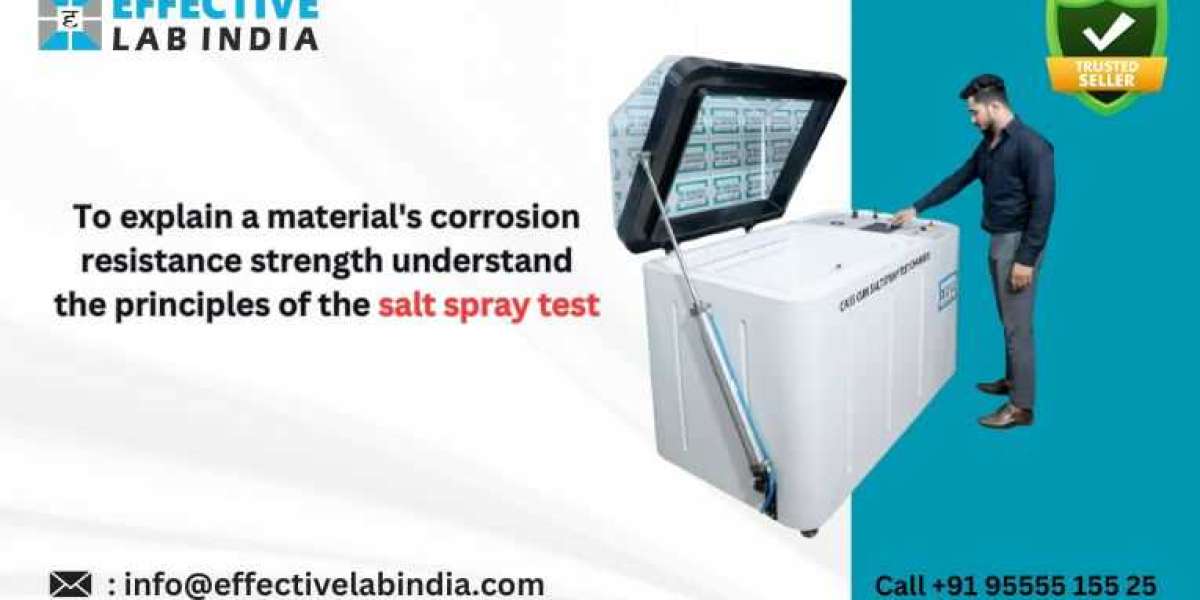Materials, particularly metals, weaken naturally over time due to a process called corrosion. Everyday objects like tarnished metal fixtures and corroded auto components are examples of it. In many industries where the longevity and safety of metal components are critical, such as the automotive and aerospace industries, it is imperative to understand a material's resistance to corrosion. The salt spray test is one of the most widely used techniques to assess this resistance.
What Is Corrosion?
In simple terms, corrosion is the slow, chemical interactions with the atmosphere that lead to a material's (typically metal) progressive deterioration. The most common type is rusting, which is the result of iron combining with moisture and oxygen to create iron oxide. Numerous other metals, however, can also be impacted by corrosion, and each will respond differently based on the environment and the nature of the substance.
Why Is Corrosion Resistance Important?
Severe structural failures, financial losses and safety risks can result from corrosion. Making sure that materials have a high corrosion resistance is essential in areas where they are exposed to hostile conditions, like the chemical or maritime industries. This not only increases a product's lifespan but also lowers maintenance expenses and prevents mishaps.
Introduction to the Salt Spray Test
The salt spray test, commonly referred to as the salt fog test, is a common and standardised technique for determining how resistant a material or coating is to corrosion. It entails subjecting the substance to a regulated environment that mimics accelerated corrosive circumstances, generally with the use of a salt solution. We can determine the corrosion resistance of a material by measuring the time it takes for corrosion to start.
Understanding the Basics of the Salt Spray Test
History and Development of the Salt Spray Test
The salt spray test was created as a rapid and reasonably easy method of assessing corrosion resistance in the early 1900s. It has evolved into a standard procedure throughout time as a result of criteria established by several organisations, such as ASTM International, to guarantee testing uniformity.
Purpose and Applications of the Salt Spray Test
The salt spray test's main objective is to create a controlled environment that causes salt's corrosive effects while simulating potential environmental circumstances that materials can be faced with. This test is commonly used in sectors including automotive, aerospace, and marine applications where items are subjected to salty conditions. It helps in the selection of the optimum coatings and materials for corrosion resistance by engineers and manufacturers.
How the Salt Spray Test Works
A material sample is constantly exposed to a fine mist of saltwater solution in a sealed salt spray chamber during the salt spray test's operation. To ensure that the test findings are reliable and reproducible, the chamber's conditions are closely regulated.
Key Components of the Test
Typically, the salt spray test chamber is made up of a heating element to maintain a certain temperature, a compressor to create mist, and a reservoir filled with a saline solution (commonly sodium chloride). Because the samples are angled, the salt mist may settle uniformly on their surface.
Test Environment Setup
In order to replicate real saltwater, the pH of the saline solution is kept between 6.5 and 7.2 and the chamber is kept at a constant temperature of typically about 35°C (95°F). Depending on the substance being tested and the intended results, the test might take anything from a few hours to many weeks, during which time the salt mist is sprayed constantly.
Test Duration and Interpretation of Results
The test's length might vary greatly because it usually lasts anywhere from 24 to 1,000 hours or longer. Following the test, the samples are examined for corrosion indicators like pitting or rust. The corrosion resistance of the material may be inferred from how long it takes for these symptoms to manifest. Long-term exposed materials with little corrosion are regarded as extremely resistant.
Practical Applications of Salt Spray Testing in Industries
Automotive Sector
Within the automotive sector, where automobiles encounter a range of environmental factors, such as road salt, the salt spray test is a commonly employed technique to evaluate the longevity of components and coatings. It makes sure that cars can resist corrosion for the duration of their anticipated life.
Defence and Aerospace
Because these materials are used in hostile conditions, corrosion resistance is essential for aerospace and defence applications. A battery of tests, including the salt spray test, is used to evaluate coatings and materials for use in spacecraft, aviation, and military hardware.
Marine Applications
The salt spray test is especially important for materials and coatings used in ships, offshore platforms, and other marine constructions because of the high salinity of marine settings. The test aids in the selection of materials that do not significantly deteriorate after extended exposure to seawater.
Electronics and consumer goods
Corrosion resistance is crucial even in consumer items like electronics and home appliances. The salt spray test can assist producers in making sure that, even in the face of moisture and salt, their goods maintain their functionality and aesthetic appeal over time.
Best Practices for Conducting and Using Salt Spray Tests
Proper Sample Making
The preparation of the samples before to testing can have a big influence on the outcome. It's crucial to make sure that samples accurately depict the finished product and that coatings and treatments are applied in a way that would mimic real-world application.
Maintaining Uniform Test Conditions
The test parameters, such as temperature, humidity, and salt solution concentration, must be constant to get accurate findings. Any deviation might provide unreliable or non-reproducible outcomes.
How to Use Test Results for Material Selection
It is important to take into consideration the particular environment in which the material will be utilised when choosing materials based on the outcomes of salt spray tests. Although the test produces useful information, it should only be a small portion of a more comprehensive review process that also incorporates data on actual performance and other testing techniques.
In summary
Comprehending the properties of corrosion resistance is essential to guaranteeing the durability and security of materials utilised in diverse sectors. Although not without its drawbacks, the salt spray test is an invaluable resource for determining a material's resistance to corrosive conditions. Manufacturers and engineers may make educated judgements about material selection and product design by accurately interpreting the data and taking them into account in conjunction with other considerations.
FAQs on Salt Spray Chamber
1. What does the salt spray test aim to achieve?
The purpose of the salt spray test is to evaluate the corrosion resistance of a material or coating by subjecting it to an accelerated corrosive environment, usually using a saline mist.
2. What is the average duration of a salt spray test?
The length can vary, generally spanning from twenty-four to more than a thousand hours, contingent upon the substance and standards under examination.
3. Can corrosion in real life be predicted by salt spray tests?
The salt spray test generates a more hostile atmosphere than most real-world situations, even yet it offers insightful information. It works best as a comparing tool, not as an accurate long-term performance prediction.
4. Which frequent tests are substituted for the salt spray test?
Additional studies for corrosion include field exposure, electrochemical, and cyclic corrosion tests, which may more closely mimic actual circumstances.
5. How should a sample be ready for a salt spray test?
In order to guarantee that the sample accurately depicts the finished product and that any coatings or treatments are applied as they would be in real usage, sample preparation is crucial.
6. Where I can find best salt spray chamber manufacturer in India?
When looking for the best salt spray chamber manufacturer in India, it's essential to consider factors like product quality, industry experience, customer support, and reliability. Among the top manufacturers, Effective Lab India stands out as one of the best in the field. They are known for their high-quality salt spray chambers that are designed to meet rigorous testing standards.







